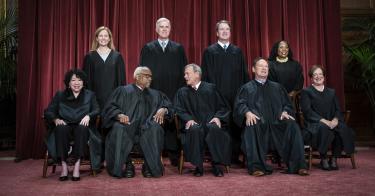The Constitution gives the “judicial power” to the Supreme Court and courts that Congress creates from time to time. America’s founders designed the judiciary to be the “weakest” branch because the judicial power is limited to interpreting and applying written law (such as the Constitution and statutes) to resolve individual legal disputes.
These decisions are important to the parties in those disputes, of course, but they were not intended to have a big impact on the country. The judiciary’s role has obviously expanded far beyond that design and, as the Supreme Court finished its 2022-23 term at the end of June, it will begin the next one on the first Monday in October. Here’s some of what the highest court in the land has been doing.
First, a little context. The Court receives thousands of requests to review cases decided by lower federal courts and state supreme courts. Based on data from the Supreme Court’s official journal, argued cases have dropped from an average of 167 during 1977-81 to 71 during the last five terms. Cases decided with full written opinions have plummeted over the same period from 153 to 67. That’s a decrease of more than 50 percent in both categories. And during the latest term, the Court heard arguments, and issued written opinions, in only 58 cases.
>>> The Dobbs Framework in Action
As an aside, this trend obviously means that the Supreme Court doesn’t need any more than nine members. Unlike the lower courts, which are divided into geographical jurisdiction, there’s only one Supreme Court. Since every justice handles every case, increasing the number of justices won’t decrease the workload. But the trend is also positive in the sense that the Court is more focused on the cases where its involvement is really necessary. The Supreme Court should not be just another bite at the judicial apple; that’s what the lower appeals courts are for.
The coverage of some high-profile cases involving divisive issues can obscure the fact that many of the Court’s decisions are unanimous, bringing together justices perceived as having different ideological perspectives. One of those, Groff v. DeJoy, is an important religious freedom decision. Title VII of the Civil Rights Act of 1964 not only prohibits employment discrimination “on account of…religion” but requires employers to accommodate their employees’ religious practices unless doing so would cause “undue hardship.” The breadth of the accommodation, therefore, depends on the meaning of “undue hardship.”
In a 1977 decision, Trans World Airlines, Inc. v. Hardison, the Supreme Court provided only a muddled answer. In attempting to define that key term “undue hardship,” the Court’s opinion included two phrases—a “de minimis” cost and “substantial” costs—that seemed to be incompatible. “De minimis” is small, minimizing an employer’s duty to accommodate, while “substantial” is much larger, expanding that duty. Unfortunately, as the Supreme Court described it in Groff, “lower courts have latched on to ‘de minimis’ as the governing standard.” and, as a result, religious employees have had little workplace protection for exercising their faith.
Fast forward to Gerald Groff, an evangelical Christian who worked for the U.S. Postal Service (USPS) and sought to avoid working on Sunday. This became more challenging when the USPS began in 2013 to facilitate Amazon deliveries. His requests for an accommodation were denied and, instead, Groff was repeatedly disciplined for refusing to work on Sunday. He resigned and sued under Title VII, but lost in the lower courts. When the Supreme Court heard arguments in April, the justices were skeptical that this “de minimis” standard was the right one. And on June 29, Justice Samuel Alito wrote for a unanimous Court that the low consensus standard “does not suffice.” Instead, he wrote, “undue hardship” is a burden that is “substantial in the overall context of an employer’s business.”
>>> Upcoming Supreme Court Cases Could Dramatically Rein in Regulatory Agencies
See what a difference the meaning of a few words can make? This decision also shows what happens when, in interpreting a statute, the Court puts aside what Congress meant by what lawmakers passed and substitutes what the Court might consider a better policy result. It took decades to correct that mistake, but employees can finally have the protection for their religious freedom that Congress enacted.
Looking ahead, the Supreme Court has already agreed to decide some important cases. In United States v. Rahimi, the Court will decide whether a federal law prohibiting possession of a firearm by someone subject to a domestic violence restraining order violates the Second Amendment. Gun control is an issue where it can be difficult to separate policy from law. Policy questions ask what government should do, but constitutional questions ask what government may do. The government may not have authority to enact good policy.
Here, the lower courts initially upheld the statute and affirmed Zackey Rahimi’s conviction for possessing a firearm while subject to a civil protection order for allegedly assaulting his girlfriend. After the lower courts had ruled, however, the Supreme Court interpreted the Second Amendment, which protects the right to keep and bear arms, more fully in a 2022 case. The U.S. Court of Appeals for the Fifth Circuit, which covers Texas (where Rahimi lives), reconsidered his case under the Supreme Court’s standard and came to the opposite result.
Judges interpret and apply the law to decide a case. Last year, the Supreme Court interpreted the Second Amendment in a way that emphasized considering current gun restrictions in light of “the Nation’s historical tradition of firearm regulation.” In Rahimi, the Court will have the opportunity to apply its interpretation.
How the Court approaches these two judicial tasks will tell us whether the justices are committed to stick to the job that America’s founder designed for it.
This piece originally appeared in Christian Renewal





